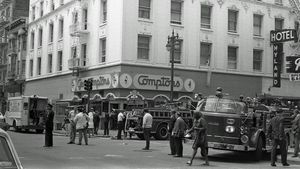Treatment GuideJust DiagnosedSex & DatingAfrican AmericanStigmaAsk the HIV DocPrEP En EspañolNewsVoicesPrint IssueVideoOut 100
CONTACTCAREER OPPORTUNITIESADVERTISE WITH USPRIVACY POLICYPRIVACY PREFERENCESTERMS OF USELEGAL NOTICE
© 2025 Pride Publishing Inc.
All Rights reserved
All Rights reserved
By continuing to use our site, you agree to our Privacy Policy and Terms of Use.
The USA Today: The South
(Part 1 in a Series of four articles taking regional overviews of the effects of HIV.)
When most Americans think about the domestic AIDS pandemic, places like San Francisco, New York City, and Los Angeles immediately come to mind'major urban centers with large populations of groups initially hit hard by HIV, including gay men and injection drug users.
But a widely held false perception that HIV remains only an urban ill has led the South to emerge as the new epicenter of the U.S. pandemic, says Kathryn Whetten-Goldstein, an assistant professor of public policy at Duke University in Durham, N.C., and the author of the book You're the First One I've Told: New Faces of HIV in the South.
'At first we thought, 'How can people in the South be 20 years into the epidemic and not realize they're at risk?''' Whetten-Goldstein says. 'But what we found out through our studies is that people in the South genuinely didn't know that they could be HIV-positive. They still thought it was a gay disease or that they could literally recognize a person who is HIV-positive.'
As a result of these misconceptions, many Southerners continue to put themselves at risk through unprotected sex, and not surprisingly, both HIV infection rates and AIDS diagnoses are exploding throughout the region.
In a report prepared for the November 2002 Southern States Summit on HIV/AIDS and STDs, the Kaiser Family Foundation showed that 40% of people living with AIDS and 46% of new AIDS cases are in the South, despite the region being home to a little over one third of the U.S. population. Of the 25 cities nationwide with the highest concentrations of HIV infection, 18 are in the South'with eight in Florida alone. The South is also the only region of the country where AIDS diagnoses continue to increase, according to the Kaiser study.
The reasons for this growing problem are as diverse as Southern culture itself, says Gene Copello, executive director of Florida AIDS Action. But when AIDS experts began to examine a laundry list of individual risk factors linked with the spread of HIV in other U.S. populations'particularly among women and minorities'including poverty, a lack of convenient access to medical care, a large number of people without health insurance, shortages of affordable housing, high levels of real or perceived HIV-related stigma, and high incidence levels of other sexually transmitted diseases, an alarming fact became apparent. Virtually all of these high-risk factors are common, even pervasive, throughout the South.
Yet despite living in the midst of this epidemiological hotbed, many Southerners insist that HIV poses no threat to them or their communities. 'Because HIV was an urban phenomenon for the most part of the epidemic, people could dissociate themselves from the disease,' explains Paul Scott, executive director of the Resource Center of Dallas and a former director of Tennessee-based AIDS service organization Chattanooga CARES. 'People were able to say, 'It doesn't affect our community. We've got different values. We do things differently because we have a rural nature.' But now HIV has made its way into rural areas and different populations, and people still aren't thinking about it differently.'
They also aren't talking about it or about the routes in which the virus is spreading in the South, notes Rudolph Carn, executive director of Atlanta-based National AIDS Education and Services for Minorities. 'We still don't want to admit that people are having sex,' he says. 'Georgia has one of the nation's highest levels of teen pregnancy'but no one is having sex? The South has the nation's highest levels of STDs'but no one is having sex? The South just doesn't want to deal with sex at all'heterosexual sex, homosexual sex, it doesn't matter.'
The subject is particularly taboo in two bedrocks of Southern culture where HIV prevention messages could carry significant weight'in churches and schools. 'Unfortunately, there's still a lot of ministering from the pulpit,' Scott says of why many Southern churches still ignore HIV issues or label those who contract the infection as sinners.
Carn firmly believes that churches, particularly black houses of worship, deliberately avoid addressing AIDS because of deep-rooted homophobia and the ongoing belief that HIV afflicts only gays. But, he adds, as more and more churchgoers have friends and family members becoming infected or falling ill, sheer numbers will ultimately force ministers to acknowledge that HIV exists within their churches.
'You can turn your back only for so long while it's raging around you,' Carn says. 'Eventually, you're going to have to deal with it, whether you like it or not.'
Schools in the South, however, are becoming even more conservative and more reluctant to address HIV, despite the growing AIDS problem in the region. Many Southern states, like Texas and North Carolina, mandate that school-based sex education programs teach abstinence as the only method of HIV and STD prevention. In states that don't require an abstinence-only curriculum, many local school boards opt for it anyway. By doing so, politicians and school administrators are denying youth information that could ultimately save their lives, says Copello.
'It's very important that people have all the tools they need to remain safe from HIV, and abstinence can play a role in that,' he notes. 'But we know that people across the region are sexually active and they need information to protect themselves, and that includes information about condoms.'
Because of classroom bans on safer sex instruction, Copello says HIV prevention organizations across the South have had to become 'very creative' in their efforts to reach at-risk youth. 'There are shelters for high-risk youth, a number of organizations for gay and lesbian youth, various other youth programs,' he explains. 'We're going to have to take advantage of all of these and have a multifaceted approach. Schools are just one element.'
Traditional HIV prevention, testing, and treatment campaigns also are going to have to adjust to meet the unique demographics of the South, where many HIV-infected people live in smaller cities and rural areas. That includes outreach programs to convince Southerners who wrongly perceive themselves as being at low risk for infection to practice safer sex and to be tested for HIV antibodies. 'Slow but sure repetition is the key to getting the message across,' says Chris Parsons, director of advocacy and community relations for AID Atlanta.
That approach has proved successful in Florida, Copello notes. An aggressive, yearlong 'Know Your Status' campaign in 2002 led to 275,000 Florida residents being tested'the highest number of any Southern state.
But even when patients have been identified as HIV-positive, getting them'and keeping them'in steady care is difficult, Whetten-Goldstein says. Many simply can't afford treatment or have no health insurance. Others are forced to make long trips to and from HIV clinics in distant cities, and are unable or unwilling to travel as often as needed. Some don't seek care because their local doctors have little experience in treating HIV-positive patients or because they are too afraid of having their family doctors learn that they carry the virus. Others don't even have a local doctor to turn to.
So if the patients won't or can't get to the services, it's time for the paradigm to shift so that service organizations begin getting to the patients, Copello says. A good way to begin such outreach, he adds, is by taking rapid-format HIV test kits to rural areas. The OraQuick Rapid HIV-1 Antibody Test, recently approved by the Food and Drug Administration, can provide results in as little as 20 minutes without the need for sophisticated lab work, allowing street outreach programs to test people in their own communities.
'We also need to have culturally and linguistically competent prevention programs targeted specifically at these hardest-to-reach communities,' he notes. Chief among these targeted groups will be African-Americans, who now account for about 53% of all HIV and AIDS cases in the South.
To accomplish this, outreach efforts will first have to break through an immense barrier caused by widespread fear and misinformation about HIV and those infected with the virus, says Bill Arnold, chairman of the Washington, D.C.'based AIDS Drug Assistance Program Working Group. That stigma often prevents even members of high-risk groups from determining whether they are infected.
As a result, up to half of all HIV infections in some Southern states are not identified until the onset of AIDS-related opportunistic infections. That's the case in Alabama, says Kathie Hiers, chief executive officer of AIDS Alabama. These late diagnoses are problematic, she says, not only because they require an immediate need for aggressive treatment, sometimes even expensive hospital stays, but also because people with undiagnosed infections likely infected others in the months and years that they were unaware they carried the virus.
Preventing these worst-case scenarios is only one of the goals of the recently formed Southern AIDS Coalition'an advocacy group representing 13 Southern states and the District of Columbia'and a document prepared by the group called the 'Southern States Manifesto on HIV/AIDS and STDs in the South: A Call to Action.' The manifesto spells out in detail the problems facing Southern states and lists steps the coalition believes are necessary to contain the regional epidemic.
One specific objective is convincing federal, state, and local officials and lawmakers that funds for research, testing, prevention, and treatment in Southern states should be boosted quickly and significantly. Because of complicated federal funding formulas, some regions of the country with a large numbers of accumulated AIDS cases since the beginning of the pandemic'including deceased patients'continue to receive disproportionately large shares of the federal funding pie, while the South receives inadequate funding, Hiers says. 'That discrepancy just exacerbates the problem.'
For example, Florida receives about 5% of federal prevention funds but currently has about 12% of the nation's HIV-positive population. Federal prevention money also goes to where HIV infections are reported, which favors the urban centers to which many rural patients travel for testing and treatment, Hiers notes. This diverts money away from the locales where the new infections are actually occurring. 'We think the funding should follow the epidemic,' Copello says.
Another important goal listed in the 'Southern States Manifesto' is to establish advocacy programs that encourage HIV-positive people to actively work to help themselves and their peers. This includes not only involving HIV-positive people in demanding new programs and increased funding for existing services but also helping them to take the scary step of coming forward to put a face on a sometimes overwhelming, impersonal issue.
'I think we can turn things around in the South, but people really do have to start to scream,' Whetten-Goldstein says. 'I feel that from about 1996 to now there has been a growing sense of panic, but it's been said that we needed to get to that level of panic before anything could be done. Now we need to grab that momentum and get in people's faces like ACT UP did in urban areas. We have to stand up and scream.'
From our Sponsors
Most Popular
“So much life to live”: Eric Nieves on thriving with HIV
September 03 2025 11:37 AM
Thanks to U=U, HIV-positive people can live long, happy, healthy lives
July 25 2025 2:37 PM
The Talk: Beyond the exam room
August 13 2025 3:15 PM
BREAKING: Supreme Court rules to save free access to preventive care, including PrEP
June 27 2025 10:32 AM
Messenger RNA could be the key to an HIV vaccine — but government cuts pose a threat
August 20 2025 8:02 AM
“I felt like a butterfly”: Niko Flowers on reclaiming life with HIV
July 23 2025 12:22 PM
Dancer. Healer. Survivor. DéShaun Armbrister is all of the above
July 02 2025 8:23 PM
The Talk: Starting the conversation
July 25 2025 4:47 PM
The lab coat just got queer
August 21 2025 10:00 AM
Plus: Featured Video
Latest Stories
HIV-positive men stage 'Kiss-In' protest at U.S.-Mexico border
December 01 2025 12:56 PM
What the AIDS crisis stole from Black gay men
December 01 2025 6:00 AM
Amazing People of 2025: Javier Muñoz
October 17 2025 7:35 PM
It’s National PrEP Day! Learn the latest about HIV prevention
October 10 2025 9:00 AM
“I am the steward of my ship”: John Gibson rewrites his HIV narrative
September 16 2025 2:56 PM
The Talk: Owning your voice
August 25 2025 8:16 PM
The Talk: Navigating your treatment
August 01 2025 6:02 PM
How the Black AIDS Institute continues to fill in the gaps
July 25 2025 1:06 PM
1985: the year the AIDS crisis finally broke through the silence
June 26 2025 11:24 AM
VIDEO: A man living with HIV discusses his journey to fatherhood
June 10 2025 4:58 PM
Trump admin guts $258 million in funding for HIV vaccine research
June 03 2025 3:47 PM
Grindr is reminding us why jockstraps are so sexy and iconic
May 02 2025 5:36 PM
HRC holds 'die-in' to protest Trump health care cuts
April 28 2025 2:11 PM
Two right-wing Supreme Court justices signal they may uphold access to PrEP and more
April 21 2025 4:10 PM
500,000 Children at Risk: PEPFAR Funding Crisis
April 08 2025 3:51 PM
Broadway's best raise over $1 million for LGBTQ+ and HIV causes
April 03 2025 7:15 PM
The Talk Season 5 premieres this spring with HIV guidance for the newly diagnosed
March 26 2025 1:00 PM








































































